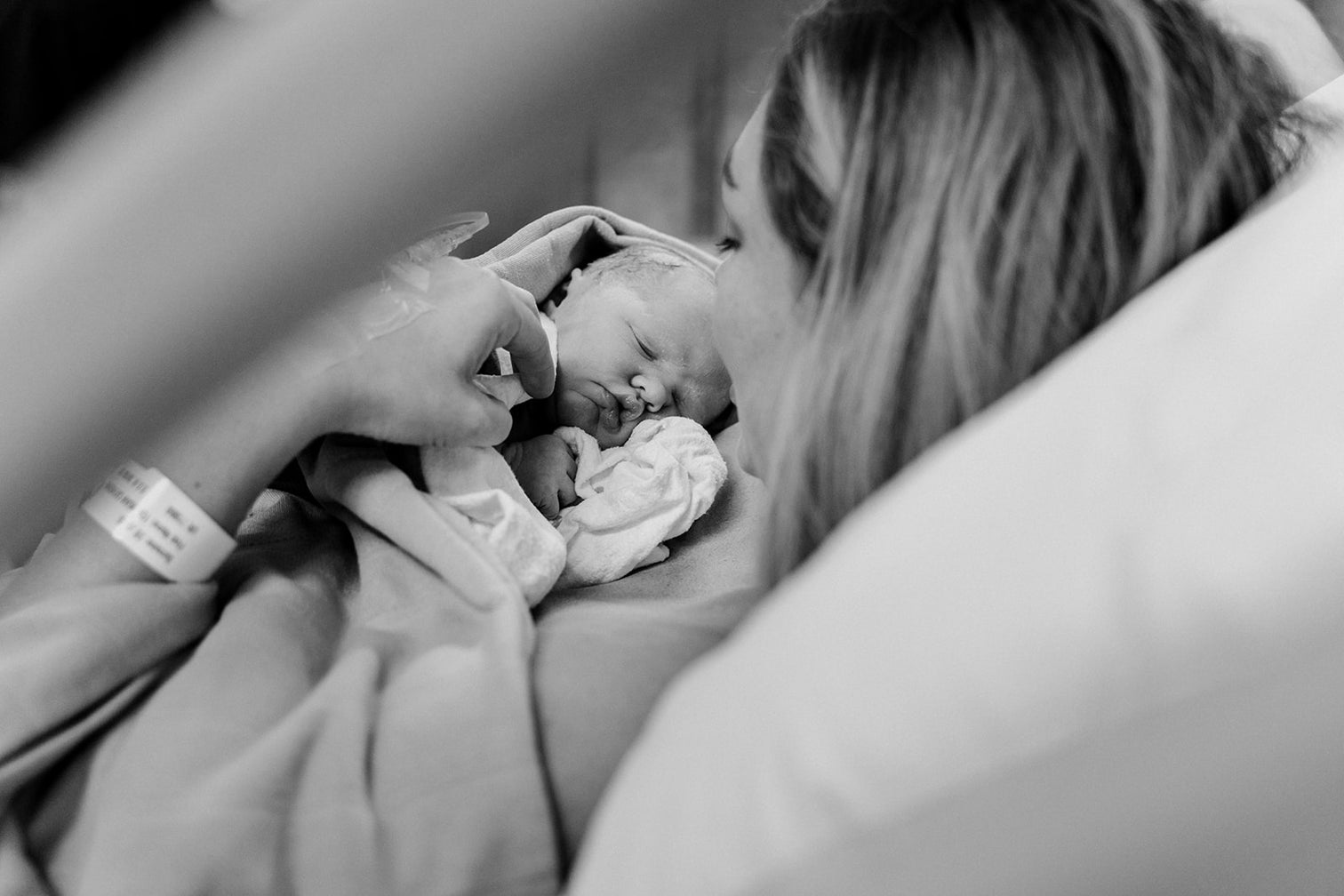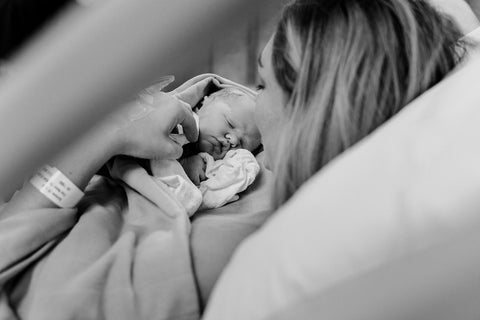The first breastfeed

After your baby is born, he or she will be placed on your chest and immediately have skin to skin, if possible, to start the bonding process. This time is precious for you, your partner and your baby. This is the beginning of the baby’s transition to their external environment or extra-uterine life, and finally meeting their parents face to face. Having post-delivery skin to skin on your chest gives them access to your breasts. They may or may not feed straight away, but it’s great to give them the opportunity to do so.
This first hour of your baby’s life is often known as the ‘golden hour’. During this special time, you can ask for the lights to be dimmed and the room to be quiet so you and your partner can get to know your baby in a peaceful space.
The effects of skin to skin and the first breastfeed
The golden hour is time is for you to enjoy the skin to skin contact and relaxed cuddles with your newborn. Skin to skin is the best way for your baby to adjust to the outside world, in a place they feel safe and secure. It has multiple benefits for you and your baby, with most resulting from the release of a hormone called oxytocin. Benefits of skin to skin for your baby also includes regulating their physiological needs, such as temperature, breathing, heart rate, blood sugar levels, and encourages the transfer of normal flora, or friendly skin bacteria from your body to the baby’s.
Providing your baby with unrestricted access to your chest is the best practice to assist with positive breastfeeding outcomes. This skin-to-skin contact and the first breastfeed increase the oxytocin hormone in the bloodstream of both you and your baby.
Effects of Oxytocin: (‘Oxytocin effects in mothers and infants during breastfeeding’, by Moberg & Prime)
- Oxytocin is essential for the release of colostrum (baby’s first milk) and helps to increase your body’s ability to produce more breastmilk. This usually results in your milk coming in 3-4 days after birth
- Oxytocin also causes your uterus to contract, which helps expel your placenta as well as reduces blood loss at birth and in the postpartum period. You may also feel period-like cramps when you are breastfeeding in the days after birth as your uterus contracts, these are known as the ‘afterbirth pains’
- The other fabulous effect of oxytocin is its ability to decrease your stress hormone known as cortisol, which reduces anxiety and makes you feel sleepy and relaxed when you breastfeed
- When your baby releases oxytocin, it helps to keep them calm, minimise crying and assist them to develop a secure attachment with you and your partner

When does the first breastfeed happen?
If you plan on breastfeeding your new baby, the golden hour is normally the time when your little one initiates their first breastfeed, or soon after. It is best if your baby breastfeeds as soon as they show interest after birth. This is because when they latch on the breast and begin to suck, your body will be stimulated and initiate an increase in your milk supply. The general recommendation is to avoid weighing or dressing your baby in that first hour, or at least until after their first breastfeed. You can make this request to your midwife or obstetrician and even include it in your birth preferences.
If you have a C-section, planned or unplanned, your midwife will do their best to try and give you and your baby skin to skin during the first golden hour. If your little one is well after a C-section, your midwife will often bring them to you for skin to skin while the surgeon finishes the procedure, and then you can continue skin to skin in recovery through to the first breastfeed. While you are in theatre and the recovery room, the environment won’t be quiet with dim lighting; however, once you are in the postnatal ward, you and your partner can have some relaxing skin to skin with your baby.
Sometimes birth can be unpredictable, and things don’t always go as planned. Your midwife or OB will be able to guide you on if you have any questions.
What is the first breastfeed like?
After birth, your baby will be given the opportunity of skin to skin on your chest listening to your heartbeat, as they have done for the past 9 months. Baby may cry or open their eyes to start to look around. While your baby is enjoying skin to skin, you can support their body, and let them attempt to find their own way to your breast and self-attach. This is known as the ‘breast crawl’, where your baby will use their arms and legs to make their way to your breast. Following the darkened area of your areola and nipple, your baby will move their head towards your nipple until they can feel it with their mouth, open their mouth wide and attach to the breast. The baby-led attachment technique, such as the Thompson Method, is now encouraged in most hospitals. If your baby doesn’t self-attach, ask your midwife to help alter the position of you or your baby to encourage attachment to the breast. After the first breastfeed, your baby can then be examined and weighed by your midwife and have skin to skin with your partner.
The first breastfeed, as well as the subsequent breastfeeds in the early days, might be uncomfortable for you but should never hurt. This discomfort is due to your nipples not being used to the strong sucking reflex of your baby. The first few days of breastfeeding can be especially uncomfortable, but your body will get used to the sensation of breastfeeding.
If your baby doesn’t attach well to the breast, your nipples will hurt, and this may cause damage to your skin. Prevention is better than cure, so try re-attaching your baby or seeing a lactation consultant if the pain continues. After each feed, apply some soothing, healing Lovekins Nipple Balm. This natural and toxic-free blend helps to nourish the skin with Indigenous superfood ingredients.
Sometimes that golden hour or the first breastfeed is unlike what you imagined; while that can be disappointing, a debrief with your midwife or a social worker can be beneficial.

What if my baby and I are separated after birth?
There are a few different reasons why you and your newborn may be separated after birth temporarily. Common reasons include when baby has to be transferred to the neonatal intensive care unit (NICU) or special care nursery (SCN) for observation, or when you need to go to theatre after birth for any investigations. If the reason for being separated after birth is non-critical, you may still be able to have some skin to skin with your baby before the separation. If you are unable to be with your baby after birth but your partner can (for example, you need to go to theatre,) encourage your partner to have skin to skin with your baby. This will ensure that your baby still gets all the benefits of skin to skin and is kept warm and safe until you are able to have skin to skin time with them.
In these situations, it is good to point out that the first breastfeed isn’t always essential. Although it is really important to express as soon as you can to initiate your milk supply so you can work towards breastfeeding when you and your baby are ready. You can give your baby any colostrum you may have expressed in the antenatal period, but if your baby is away from you for an extended period of time, it is important to express colostrum every 3-4 hours. Ask your midwife if you are unsure about the technique of hand expressing.
Points if your newborn is in NICU or SCN:
- Colostrum is extremely beneficial for your baby if they are unwell or premature, as it contains a high number of antibodies and proteins to fight off illnesses and help build baby’s immune system.
- Remember that your baby can generally still have skin to skin with you or your partner if they are in NICU or SCN and stable, because skin to skin provides so many amazing effects for both of you.
- If you cannot be with your baby, ask your partner or the midwife to take photos and videos of your baby for you. Looking at the footages will help the bonding process for you, as well as help the release of oxytocin when you are expressing.
- Ask your hospital if they have ‘cuddle hearts’ - these are small pieces of fabric in heart-shape. Cuddle hearts can be placed in your top or bra to gather your scent and are then put in your baby’s cot so they can smell their mum at all times. You can also use a singlet or another small piece of clothing if cuddle hearts are not available.

If your first breastfeed doesn’t occur like you had imagined, or doesn’t happen at all, remind yourself that exclusively breastfeeding your baby is still very achievable. Keep expressing regularly to maintain a good milk supply, have skin to skin with your little one as much as you can. If you cannot be with your baby, look at footage of them while you express. Use support from midwives and lactation consultants in the hospital, especially when you begin to transition your baby from having expressed milk to breastfeeding directly from the breast. You can read more about Lovekins Nipple Balm and it’s healing properties here.
Blog written by midwife Aliza Carr from Bumpnbub.
*General advice only and does not replace the need for medical advice*.
